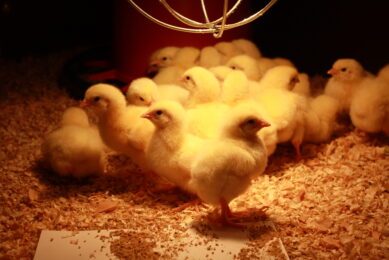Gene editing is speeding up disease control and more in poultry

In poultry, as with other livestock categories, genetic advances are typically made in extensive breeding and selection programmes. However, tackling specific issues and diseases with traditional selection is difficult or even impossible. With the introduction and growing expertise in gene editing techniques, things could speed up.
Gene editing allows livestock breeding programmes to introduce desired changes in a controlled way and at a more rapid pace than is possible using only conventional selection. As Dr Alison van Eenennaam explains, gene editing involves guiding enzymatic DNA ‘scissors’ (DNA strand site-directed nucleases) to do a targeted, specific cut at a predetermined DNA sequence. She is also the geneticist from the University of California, Davis who used gene editing a few years ago to create a bull calf that could produce gender-skewed sperm.
Regarding how gene editing can work in livestock breeding, Van Eenennaam says: “Depending on how the cut is repaired, you can have inactivation of the gene that’s located at the target site, or an alteration in the functionality of that gene. Alternatively, there could also be DNA introduced at the cut site using a DNA-repair template containing a sequence originating from that organism, another of its species or from another species.”
Genetic engineering, however, is a 20-year-old technique that is not targeted. Foreign genetic material is introduced into the genome using a DNA-repair template in the absence DNA strand site-directed nucleases. The ‘GalSafe’ pigs (created in 2002) and ‘AquAdvantage’ salmon (created in 1989) became the first genetically-engineered (transgenic) farmed animals approved in the US for human consumption in 2020.
Legal use
Gene editing regulations are a complex matter and many geneticists, including Van Eenennaam, consider regulatory frameworks in several jurisdictions restrictive and illogical. Gene editing in the EU, for example, is regulated similarly to genetic engineering. Even more strangely, in the US, gene editing of livestock is currently regulated by the US Federal Drug Administration, which classifies any intentional genome alteration in an animal’s genome as a new animal drug, and regulatory frameworks used for drugs, therefore, apply.
Governments in other jurisdictions such as Brazil, Australia and Argentina view gene editing as akin to conventional breeding, at least in situations where a gene is knocked out and no novel or foreign DNA is introduced.
Disease control potential
In poultry and other types of livestock, traits that involve a single gene (such as feather colour) are very suitable for gene editing, whereas traits that involve many genes (such as feed conversion ratio or growth rate) are not.
Complete disease prevention is a very exciting area for applying gene editing because in many potential scenarios, knocking out a single gene prevents a disease process from taking hold in the first place. For example, you could knock out the production of a cell-surface receptor that is used by a virus or bacteria for its attachment and entry into a cell.
Indeed, new interventions for both existing and newly-emerging poultry pathogens can be achieved with gene editing in novel in vitro cell culture systems, according to a group of researchers from The Roslin Institute in Scotland in a recent review paper entitled ‘Chicken genome editing for investigating poultry pathogens’.
Progress so far
In another paper on gene editing in poultry, other scientists from The Roslin Institute and the University of Edinburgh point to an achievement as far back as 2017 when researchers made gene edits to chicken somatic cell lines, resulting in resistance to avian leucosis virus. The gene edit targeted the cellular receptor used by a particular strain of the virus.
These scientists also point to other researchers who, in 2016 and 2019, deleted a small region of chicken DNA that plays “a key role in avian influenza virus replication in both chicken and waterfowl”.
They summarise that while “many gene editing approaches focus on targeting host genes involved in mediating entry of the virus, with a special focus on receptors, as the example for avian influenza shows, host genes play an important role in other steps of the pathogen replication cycle and also provide editing targets for disease resilience or resistance”.
Welfare and sustainability
There is also hope that the thorny issue of culling male chickens from laying hen breeders can be solved with gene editing. Governments in Germany and France have already banned this practice requiring the egg industries there to use technologies that detect the sex of embryos before the egg hatches. Most other European Union countries are looking at similar bans. However, geneticists in Israel are using gene editing to create hens that lay eggs from which only female birds hatch.
A group at the Israeli Agricultural Research Organization Volcani Centre has achieved the creation of hens that only produce female chicks, following 7 years of research with an American-Israeli firm called Huminn. When eggs laid by the gene-edited hens are exposed to blue light for several hours, the male embryos fail to develop. Female embryos are unaffected by the blue light, develop normally and hatch when fully developed.
Future potential
Achieving immunity to disease in poultry has, so far, been a very difficult challenge. Dr Huaijun Zhou, professor and chancellor fellow at the University of California, Davis, notes that at this point, geneticists are primarily using gene editing in poultry to understand the functions of various genes in the poultry genome.
Zhou is also director of the Feed the Future Innovation Lab for Genomics to Improve Poultry and a recipient of the NAS Prize in Food and Agriculture Sciences. But he sees a bright future ahead: “If gene editing can be used to control disease, this would be a very welcome achievement with great potential.”
He concludes that despite the great work done already, the scientific community has just started to scratch the surface of possible benefits from gene editing.













